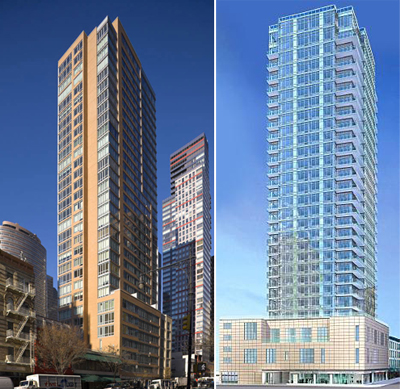Trending
Three Ten — worthier than its neighbor
Several anonymous authors have seen fit to comment on my pieces in this space and they have taken me to task, in terms that are hardly benign, for not being nicer to new developments. Especially in these dark days for the New York real estate market, it behooves us all, they suggest, to emphasize the positive.
To that end, I have decided to write about the Veneto, Also Known As 250 East 53rd Street. True, I will not be any kinder than usual to the condominium building in question — for it is, as architecture goes, a very poor piece of work. But I choose to write about a relatively new condo, in order to draw attention to its far worthier neighbor, 310 East 53rd Street, directly across the street.
In these two developments, completed over the last few years, it is possible to see the difference between an architect and a developer, on the one hand, who are making an honest effort, and on the other, a team that cynically imagines that such efforts would be wasted on New Yorkers.
First the good news: Three Ten, as it is called, was developed by Macklowe Properties and designed by SLCE Architects, a firm that is responsible for a number of distinguished buildings around the city. They have conceived this pale 32-story structure as a neatly rectalinear tower surrounded at each corner with wrap-around balconies separated by curtain-walled facades. The effect is simple and yet rich and subtle. The base, rising up to about the fourth floor, is clad in luxurious limestone, its tall windows adorned with spare metal mullions.
 From left to right: The Veneto, Three Ten
From left to right: The Veneto, Three TenIn shape, 250 East 53rd is very similar. It is roughly the same height and it is conceived as a high-rise tower by Davis Brody Bond and developed by the Related Companies. Like its neighbor, it is largely modernist in conception, but with none of the contextualist limestone grace-notes of 310. A tactlessly two-tone building of reddish and yellowish brick, it represents the most depleted form of Modernism, as conceived in the late 1960s and unregenerated since that time.
Granted that in the crazed New York market, few people buy real estate for a building’s exterior. But it would be nice if developers and architects realized that pedestrians and neighbors will have to live around this building for decades to come. The weakness of the Veneto is especially galling coming from Davis Brody Bond, which has been capable of far better work.
James Gardner, formerly the architecture critic of the New York Sun, writes on the visual arts for several publications.




